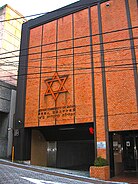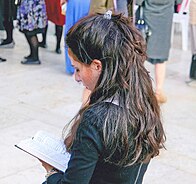
Ancient Judaism is an essay written by the German economist and sociologist Max Weber in the early 20th century. The original edition appeared in the 1917–1919 issues of the Archiv für Sozialwissenschaft und Sozialpolitik. Marianne Weber, his wife, published the essays as Part Three of his Gesammelte Aufsatze zur Religionssoziologie in 1920–1921. An English translation was made in 1952 and several editions were released since then.

Jewish identity is the measure of one's view as a Jew in relation to oneself and the world. Identity is not a cognitive format, rather a presentation of actions and behaviors one employs in their sense of Judasim. The identity of a Jew is reflexive and probes input from within, and output projection. This is extracted by means of fulfilling a calling to greatness and humility. A Jew can define themselves Jewish in a variety of formats, yet, as long as they maintain diligence to the core realm of Jewsih belonging, which populate activity and loyalty to the Torah of Moses, the principles of faith, and the monotheistic standings granted at Mount Sinai, they are maintained in regulatory Jewish definitions. On a simple level, every Jews remains a Jew irrespective of their observations, yet a spark of Gdliness manifests itself in the heart of the distant Jew, claiming its spotlight with unsensored feelings and dispositions for awakening and being honest to their hereditary call of origin. The latter part of seen as the Chasidik conceptualization as related to being Jewish.Under a broader definition, Jewish identity does not depend on whether a person is regarded as a Jew by others, or by an external set of religious, or legal, or sociological norms. Jewish identity does not need to imply religious orthodoxy. Accordingly, Jewish identity can be cultural in nature. Jewish identity can involve ties to the Jewish community. Orthodox Judaism bases Jewishness on matrilineal descent. According to Jewish law (halacha), all those born of a Jewish mother are considered Jewish, regardless of personal beliefs or level of observance of Jewish law. Progressive Judaism and Haymanot Judaism in general base Jewishness on having at least one Jewish parent, while Karaite Judaism bases Jewishness only on paternal lineage. These differences between the major Jewish movements are the source of the disagreement and debate about Who is a Jew?.
The American Jewish Year Book (AJYB) has been published since 1899. Publication was initiated by the Jewish Publication Society (JPS). In 1908, the American Jewish Committee (AJC) assumed responsibility for compilation and editing while JPS remained the publisher. From 1950 through 1993, the two organizations were co-publishers, and from 1994 to 2008 AJC became the sole publisher. From 2012 to the present, Springer has published the Year Book as an academic publication. The book is published in cooperation with the Berman Jewish DataBank and the Association for the Social Scientific Study of Jewry.

Jonathan D. Sarna is the Joseph H. and Belle R. Braun Professor of American Jewish History in the department of Near Eastern and Judaic Studies and director of the Schusterman Center for Israel Studies at Brandeis University in Waltham, Massachusetts.
Samuel C. Heilman is a professor of Sociology at Queens College of the City University of New York who focuses on social ethnography of contemporary Jewish Orthodox movements.

Sergio Della Pergola is an Italian-Israeli demographer and statistician. He is a professor and demographic expert, specifically in demography and statistics related to the Jewish population.
Charles S. Liebman was a political scientist and prolific author on Jewish life and Israel. A professor at Bar-Ilan University, he previously served on university faculties in the United States.
The Marshall Sklare Award is an annual honor of the Association for the Social Scientific Study of Jewry (ASSJ). The ASSJ seeks to recognize "a senior scholar who has made a significant scholarly contribution to the social scientific study of Jewry." In most cases, the recipient has given a scholarly address. In recent years, the honored scholar has presented the address at the annual meeting of the Association for Jewish Studies.

Sociology is a social science that focuses on society, human social behavior, patterns of social relationships, social interaction, and aspects of culture associated with everyday life. It uses various methods of empirical investigation and critical analysis to develop a body of knowledge about social order and social change. While some sociologists conduct research that may be applied directly to social policy and welfare, others focus primarily on refining the theoretical understanding of social processes and phenomenological method. Subject matter can range from micro-level analyses of society to macro-level analyses.
Jack Nusan Porter is an American writer, sociologist, human rights and social activist, and former treasurer and vice-president of the International Association of Genocide Scholars. He is a former assistant professor of social science at Boston University and a former research associate at Harvard's Ukrainian Research Institute. He is a research associate at the Davis Center for Russian and Eurasian Studies at Harvard University, doing research on Israeli-Russian relations, especially the life of Golda Meir, as well as doing work on mathematical and statistical models to predict genocide and terrorism and modes of resistance to genocide. His most recent books are Is Sociology Dead?, Social Theory and Social Praxis in a Post-Modern Age, The Genocidal Mind, The Jew as Outsider, and Confronting History and Holocaust.
The Association for the Social Scientific Study of Jewry (ASSJ) is a cross-disciplinary organization of individuals whose research concerns the Jewish people throughout the world founded in 1971.

Steven M. Cohen is an American sociologist whose work focuses on the American Jewish Community. He served as a Research Professor of Jewish Social Policy at Hebrew Union College-Jewish Institute of Religion, and the Director of the Berman Jewish Policy Archive at Stanford University until his resignation in July 2018 after he was accused of sexual harassment.
Celia Heller was an American sociologist. She was born in Poland.
Mervin Feldman Verbit is an American sociologist whose work focuses on sociology of religion, American Jews and the American Jewish community. He is currently the chair of the Sociology Department at Touro College.
Marshall Sklare (1921–1992) was an American sociologist whose work focused on American Jews and the American Jewish Community. Sklare was the Klutznick Family Professor of Contemporary Jewish Studies and Sociology at Brandeis University. Because of his contributions to the social scientific study of Jewry, Sklare is known as the "father of American Jewish sociology".
Chaim Isaac Waxman is an American sociologist now living in Israel.
Leonard Saxe is an American social psychologist whose work focuses on sociology of religion, American Jews and the American Jewish community. He is currently the director of the Cohen Center for Modern Jewish Studies at Brandeis University.
In sociology, elite religion is defined as the symbols, rituals and beliefs which are recognized as legitimate by the leadership of that religion. Elite religion is often contrasted with folk religion, or the religious symbols and beliefs of the masses. Elite religion is then the "official religion" as championed by the leaders of a religion. Some researchers see the concept as potentially applying to a range of internal religious divisions such as orthodoxy versus heterodoxy, between the clergy and the laity, or between the religion's wealthy adherents and the poor.
Contemporary Jewry is a peer reviewed academic journal published by the Association for the Social Scientific Study of Jewry since 1977.
Norman Friedman is an American sociologist and the former chairman of the Department of Sociology at California State University, Los Angeles.










